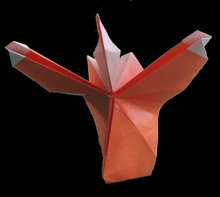
I've planned to speak a couple of things about the effects on paper of folding but then there are still one or two things still to say about paper itself and its making. Most of this comes from the fantastic Michael G. LaFosse's book "Advanced Origami" and his project Origamido.com, book which is an ultimate guide to become an artisan of papermaking and origami.
Cellulose
Continuing with our approach to paper's nature, in the first part we mentioned cellulose and its discovering in 1852 by Meillier; however, some sources points to the french biogolist Anselme Payen as the first person isolating cellulose from wood [1, 2]. This element constitutes the main component of plant's cells and is important to origami since its atomics bounds promotes the creation of long molecular fibers. Looking at the cellulose molecule (C6 H10 O5)

is possible to note that their free OH radicals can generate a very strong H2O bound and also an oriented chain, which is the origin of vegetable fibers, the greater the number of cellulose molecules bounded on this way (known as a polysacaride) the greater the resulting fibers will be and, as we saw previously, this is vital for paper strength. The cotton rag that surrounds the fruit has the purest vegetable cellulose fibers in nature and they can hold until 6000 molecules in a polysacaride. This bound is so strong that only herbivore's digesting systems can break. As an interesting fact cotton fibers can size up to 3 cm when pine wood fibers only 3 mm.
Normally first wall on plant's cells contain pure cellulose and when going deeper inside different components appears, as lignine. Next table (sorry, in spanish) shows the % contents of different types of plants:

Source: TAPPI
all this extra elements affect badly to paper's quality and lifetime and different procedures has been created to extract them from the plant, many of them chemical and heavily toxic to the environment. That's the reason why paper factories are eyestorms for nature's defending groups all over the world, since this factories throw their industrial waste normally to rivers or seacoasts, together with the fact that they change natural flora by pine trees, which roots have an strong factor of fertile earth's destruction but a shorter and cheaper time of growing and development as adult trees.
As we said, in 1852, american Benjamin Chew Tilghman patented the method to obtain cellulose from wood, by the chemical creation of cellulose sulfithe. In the world, main trend is to obtain cellulose from this source (woods), except for India (only a 40%) and China, which obtains 80% of it from other plants [1].
Finally to say that cellulose molecular bound is so strong and closed that paper is more rigid in one direction than the other, and as LaFosse says in his book if you hold a square by one edge it inclines down lower than if you hold it by the next edge on its side, because fibers trends to align in a direction. Also cellulose in insoluble on water and, when water is added to paper, fibers grow wider, not longer, and that's the reason because paper doesn't get bigger and wrinkles appears on its surface (an important fact when you try wet folding).
Beating

In Part I we saw that long fibers creates a resistant but rough paper and short fibers a softer and fine one. The chemical process to separate cellulose from plant leaves untouched and separated fibers, so if you want to get fineness it is necessary then a beating and agitating stage. This is achieved by the usage of mills and pulp circuits, most common of them is the Hollander mill (image above).
It is basically a water-pulp circuit plus a rotating mill with square gears that reduces the passage area of the liquid, beating the fibers, cutting and spreading them in the solution.
As long the time the pulp is beated, the greater its opacity and fineness of the resulting paper, also its fragility (normal paper is beated for a couple of hours and tissue paper could be more than 8 hours in the process).
The Pulp Sheet
Once the pulp solution leaves the Beating, it is possible to color it by adding retention agents and pigments. Then is necessary to create a layer of homogeneous pulp which will become the sheet of paper. One way to do it is water mixing and depositing it in a rectangular frame, as cellulose doesn't dissolve in water, it evaporates and leave the pulp layer, of course if you use a frame with a filter screen at the bottom in a way that water drops down the process is accelerated and improved. Industrial paper making spreads the wet pulp in long lines of production which controls its thickness and density.
Pressing
The wet pulp sheet is then pressed according to desired degrees of density required for paper. Here we look again at cellulose fibers since if they are smashed the area covered by them increases and also the pulp density and bounding, making paper with bigger opacity and shapping, as you can see in the next images. Some water is extracted from pulp in this stage also but normally sheets are placed between wet felts.


Driying
Finally paper is driyed by hot air until it keeps its color and natural humidity. Also it is possible to give it some finishing with special surface paints, as for shinny continuous surfaces.
This far we will reach about the processes of paper making, in next posts I will try to talk about the effects on paper of making different types of folds, as long as the effects on stress and recovering of paper and fibers, I hope you are finding this journey interesting so far ;)
Bibliography
1 http://web1.caryacademy.org/chemistry/rushin/StudentProjects/CompoundWebSites/2000/Cellulose/history.htm
2 http://en.wikipedia.org/wiki/Cellulose
3 http://www.forestprod.org/cdromdemo/pf/pf8.html
Cellulose
Continuing with our approach to paper's nature, in the first part we mentioned cellulose and its discovering in 1852 by Meillier; however, some sources points to the french biogolist Anselme Payen as the first person isolating cellulose from wood [1, 2]. This element constitutes the main component of plant's cells and is important to origami since its atomics bounds promotes the creation of long molecular fibers. Looking at the cellulose molecule (C6 H10 O5)

is possible to note that their free OH radicals can generate a very strong H2O bound and also an oriented chain, which is the origin of vegetable fibers, the greater the number of cellulose molecules bounded on this way (known as a polysacaride) the greater the resulting fibers will be and, as we saw previously, this is vital for paper strength. The cotton rag that surrounds the fruit has the purest vegetable cellulose fibers in nature and they can hold until 6000 molecules in a polysacaride. This bound is so strong that only herbivore's digesting systems can break. As an interesting fact cotton fibers can size up to 3 cm when pine wood fibers only 3 mm.
Normally first wall on plant's cells contain pure cellulose and when going deeper inside different components appears, as lignine. Next table (sorry, in spanish) shows the % contents of different types of plants:

Source: TAPPI
all this extra elements affect badly to paper's quality and lifetime and different procedures has been created to extract them from the plant, many of them chemical and heavily toxic to the environment. That's the reason why paper factories are eyestorms for nature's defending groups all over the world, since this factories throw their industrial waste normally to rivers or seacoasts, together with the fact that they change natural flora by pine trees, which roots have an strong factor of fertile earth's destruction but a shorter and cheaper time of growing and development as adult trees.
As we said, in 1852, american Benjamin Chew Tilghman patented the method to obtain cellulose from wood, by the chemical creation of cellulose sulfithe. In the world, main trend is to obtain cellulose from this source (woods), except for India (only a 40%) and China, which obtains 80% of it from other plants [1].
Finally to say that cellulose molecular bound is so strong and closed that paper is more rigid in one direction than the other, and as LaFosse says in his book if you hold a square by one edge it inclines down lower than if you hold it by the next edge on its side, because fibers trends to align in a direction. Also cellulose in insoluble on water and, when water is added to paper, fibers grow wider, not longer, and that's the reason because paper doesn't get bigger and wrinkles appears on its surface (an important fact when you try wet folding).
Beating

In Part I we saw that long fibers creates a resistant but rough paper and short fibers a softer and fine one. The chemical process to separate cellulose from plant leaves untouched and separated fibers, so if you want to get fineness it is necessary then a beating and agitating stage. This is achieved by the usage of mills and pulp circuits, most common of them is the Hollander mill (image above).
It is basically a water-pulp circuit plus a rotating mill with square gears that reduces the passage area of the liquid, beating the fibers, cutting and spreading them in the solution.
As long the time the pulp is beated, the greater its opacity and fineness of the resulting paper, also its fragility (normal paper is beated for a couple of hours and tissue paper could be more than 8 hours in the process).
The Pulp Sheet
Once the pulp solution leaves the Beating, it is possible to color it by adding retention agents and pigments. Then is necessary to create a layer of homogeneous pulp which will become the sheet of paper. One way to do it is water mixing and depositing it in a rectangular frame, as cellulose doesn't dissolve in water, it evaporates and leave the pulp layer, of course if you use a frame with a filter screen at the bottom in a way that water drops down the process is accelerated and improved. Industrial paper making spreads the wet pulp in long lines of production which controls its thickness and density.
Pressing
The wet pulp sheet is then pressed according to desired degrees of density required for paper. Here we look again at cellulose fibers since if they are smashed the area covered by them increases and also the pulp density and bounding, making paper with bigger opacity and shapping, as you can see in the next images. Some water is extracted from pulp in this stage also but normally sheets are placed between wet felts.


Driying
Finally paper is driyed by hot air until it keeps its color and natural humidity. Also it is possible to give it some finishing with special surface paints, as for shinny continuous surfaces.
This far we will reach about the processes of paper making, in next posts I will try to talk about the effects on paper of making different types of folds, as long as the effects on stress and recovering of paper and fibers, I hope you are finding this journey interesting so far ;)
Bibliography
1 http://web1.caryacademy.org/chemistry/rushin/StudentProjects/CompoundWebSites/2000/Cellulose/history.htm
2 http://en.wikipedia.org/wiki/Cellulose
3 http://www.forestprod.org/cdromdemo/pf/pf8.html



2 comments:
Great informations!
and great folds too
=)
hi steyen,
thanks :)
I've just ordered an amazing book of paper facts and properties.
Though I only want to fold something now! :D
Post a Comment